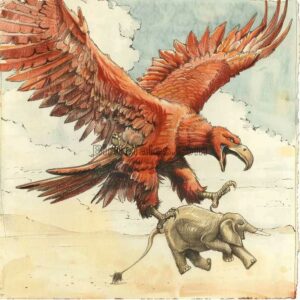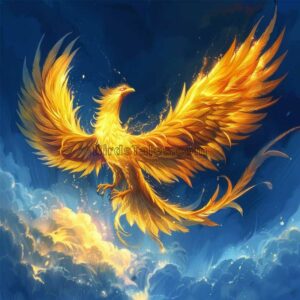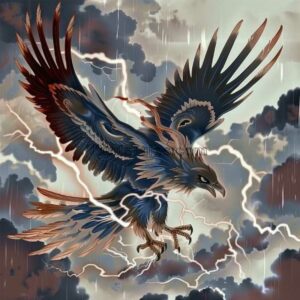Phoenix: The Eternal Flame

The Phoenix is a bird of fire. In myth, it dies in flames and is reborn from its own ashes. This cycle of death and rebirth makes it a powerful symbol of eternal renewal and resilience. Think of the Phoenix as the ultimate comeback kid. Nothing keeps it down. It falls, it burns, but it always rises again, more brilliant than before.
Phoenix in Greek and Egyptian Myths
Greek mythology paints the Phoenix as a majestic bird living for 500 years. At the end of its life, it builds a nest of aromatic wood and sets itself on fire. From the ashes, a new Phoenix emerges. The Greeks saw it as a symbol of the sun, rising and setting each day, a constant cycle of life and death.
In Egypt, the Phoenix is known as Bennu, closely tied to the sun god Ra. The Bennu bird was thought to create itself from fire. Ancient texts describe it as radiant, with golden and red feathers, much like the sun at dawn and dusk. The Egyptians believed the Bennu’s call marked the beginning of time. This bird didn’t just symbolize renewal; it was a marker of creation itself.
Modern Representations of Phoenix
The Phoenix has found a cozy spot in modern culture. It’s not just a bird from old stories. You see it in books, movies, and even tattoos. Harry Potter has Fawkes, the loyal Phoenix who aids in battles and heals wounds with its tears. Fawkes isn’t just a sidekick; he’s a symbol of hope and healing.
In X-Men, Jean Grey becomes the Phoenix, embodying immense power and transformation. This shows how the Phoenix myth fits perfectly with stories of superheroes and inner strength. It’s a reminder that even in our darkest moments, there’s potential for a fresh start.
The Phoenix also appears in business logos and brands. Companies use it to signify rebirth and resilience. It tells customers, “We rise from the ashes, stronger than before.” This mythical bird keeps on soaring, reminding us that setbacks are just setups for comebacks.
Key Myths and Symbols of Phoenix
| Aspect | Greek Mythology | Egyptian Mythology |
|---|---|---|
| Name | Phoenix | Bennu |
| Symbolism | Sun, renewal, rebirth | Creation, sun god Ra, time marker |
| Life Cycle | 500 years, burns, reborn from ashes | Self-created from fire, golden-red feathers |
| Cultural Impact | Literature, films, business logos | Ancient religious texts, art |
Noteworthy Points
- Phoenix: Burns and is reborn, symbolizes resilience.
- Greek: Lives 500 years, linked to the sun.
- Egyptian: Known as Bennu, marks creation and time.
- Modern Culture: Seen in movies, books, logos, symbolizing hope and strength.
Roc: The Colossal Bird of Prey

The Roc is a bird of legend, hailing from Arabian tales. Imagine a bird so massive it can carry off elephants. That’s the Roc. This giant bird isn’t just big; it’s a force of nature. It appears in tales of stormy skies and epic adventures, leaving everyone in awe of its sheer power.
Roc in Literature and Folklore
The Roc’s most famous appearances are in “The Arabian Nights”. Sinbad the Sailor encounters this enormous bird during his voyages. In one story, the Roc’s egg is as big as a house, and Sinbad and his crew mistakenly anger the Roc by breaking it. Talk about ruffling some feathers!
Marco Polo, the famed explorer, also mentioned the Roc in his travel accounts. He described it as a bird of incredible size, capable of snatching up large animals. Polo’s tales, mixed with the rich Arabian folklore, helped cement the Roc as a creature of legend.
The Roc’s portrayal isn’t limited to ancient texts. It pops up in modern fantasy literature too. Authors use the Roc to add a sense of wonder and danger. This bird isn’t just a plot device; it’s a symbol of the untamed, the wild, and the mysterious.
Symbolic Meanings of Roc
The Roc isn’t just a big bird; it carries big meanings. In many stories, the Roc symbolizes power and dominance. It’s a reminder of nature’s raw strength. Nothing is safe when the Roc is in the sky.
In Arabian culture, the Roc represents the storm. Its wings are said to cause mighty winds, and its presence signals trouble. This bird is a force to reckon with, embodying the unpredictable and often destructive nature of storms.
The Roc also symbolizes the unknown. It challenges heroes, pushing them to their limits. Whether it’s Sinbad or Marco Polo, those who encounter the Roc must face their fears. This bird is a test of bravery and endurance.
In modern times, the Roc inspires art and storytelling. It’s a symbol of the wild and the mysterious, a perfect fit for tales of fantasy and adventure. Its legacy lives on, reminding us that there’s always something bigger and more powerful out there, waiting to be discovered.
Key Myths and Symbols of Roc
| Aspect | Literature and Folklore | Symbolic Meanings |
|---|---|---|
| Famous Appearances | “The Arabian Nights,” Marco Polo’s accounts | Power, dominance, storms |
| Symbolism | Storms, mystery, wild nature | Test of bravery, nature’s raw strength |
| Modern Impact | Fantasy literature, art | Symbol of the untamed and mysterious |
Noteworthy Points
- Roc: Giant bird, carries off elephants.
- Arabian Nights: Sinbad’s adventures, Roc’s massive egg.
- Marco Polo: Described Roc as incredibly large.
- Symbolism: Power, storms, untamed nature.
- Modern Culture: Inspires art and fantasy, symbol of mystery and strength.
Simurgh: The Benevolent Protector

The Simurgh is a legendary bird from Persian mythology. Known for its wisdom and healing, it stands as a symbol of benevolence and protection. Unlike some mythical birds that bring chaos, the Simurgh is a helper, a guide. It’s like having a wise, feathered guardian always watching over you. This bird isn’t just about power; it’s about nurturing and healing.
Tales of Simurgh in Persian Culture
The Simurgh appears in many Persian stories, but one of the most famous is in Ferdowsi’s Shahnameh. This epic poem, also known as the Book of Kings, features the Simurgh as a protector and advisor. In one tale, the Simurgh raises Zal, a prince abandoned by his father due to his unusual white hair. The Simurgh not only cares for Zal but also provides him with wisdom that helps him throughout his life.
In another story, the Simurgh aids Rostam, Zal’s son and a great Persian hero. When Rostam’s wife experiences a difficult childbirth, the Simurgh instructs him on how to perform a cesarean section, saving both mother and child. These tales highlight the Simurgh’s role as a nurturing and wise figure, always ready to offer guidance and support.
The Simurgh is also linked to the mythical Tree of Life. Perched on this sacred tree, it is said that when the Simurgh takes flight, it shakes the branches, causing seeds of all plants to scatter across the world. This act symbolizes the spreading of knowledge and life.
Simurgh’s Legacy in Art and Society
The Simurgh has left a lasting mark on Persian art and culture. In Persian miniature paintings, the Simurgh is often depicted as a majestic, colorful bird with the body of a peacock, the head of a dog, and the claws of a lion. These intricate artworks showcase its beauty and importance in Persian folklore.
The bird also appears in Persian carpets and textiles, symbolizing protection and good fortune. Homes adorned with images of the Simurgh are believed to be blessed with its benevolent presence.
In literature, the Simurgh’s wisdom is often invoked. Poets like Rumi and Attar have written about the Simurgh, using it as a metaphor for divine wisdom and spiritual journey. In Attar’s “The Conference of the Birds,” the Simurgh represents the divine, guiding other birds on their quest for enlightenment. This story emphasizes the Simurgh’s role as a spiritual leader and source of inner truth.
Modern interpretations of the Simurgh continue to inspire. It appears in contemporary Persian art, literature, and even pop culture, symbolizing resilience and the quest for knowledge. The Simurgh remains a timeless icon of protection, wisdom, and healing, reminding us of the enduring power of myth and the universal quest for understanding and guidance.
Key Myths and Symbols of Simurgh
| Aspect | Tales in Persian Culture | Legacy in Art and Society |
|---|---|---|
| Famous Stories | Shahnameh, Tree of Life | Miniature paintings, Persian carpets |
| Symbolism | Wisdom, protection, healing | Divine wisdom, spiritual journey |
| Modern Impact | Literature, art, pop culture | Symbol of resilience, knowledge quest |
Noteworthy Points
- Simurgh: Wise, benevolent bird.
- Shahnameh: Raises Zal, aids Rostam.
- Tree of Life: Scatters seeds, spreads knowledge.
- Persian Art: Miniatures, carpets, symbol of protection.
- Literature: Rumi, Attar, metaphor for divine wisdom.
- Modern Culture: Continues to inspire, symbol of resilience and knowledge.
Thunderbird: The Storm-Maker

The Thunderbird is a powerful figure in Native American mythology. This bird doesn’t just fly; it controls the weather. With a flap of its wings, it creates thunder and lightning. Imagine a bird so powerful that storms are at its command. The Thunderbird is both a protector and a punisher, embodying the raw force of nature.
Thunderbird in Tribal Stories
Different tribes have their own tales about the Thunderbird. Among the Algonquian people, the Thunderbird is a mighty spirit who battles underwater serpents, protecting the land from these dangerous creatures. Its eyes flash lightning, and its wings thunder through the sky.
In the Sioux tradition, the Thunderbird is a guardian of the upper world. It is said to control the rains and storms, ensuring the land remains fertile. This bird is a symbol of power and protection, often depicted on totems and in tribal art.
The Ojibwe tell stories of the Thunderbird as a great teacher. It brings rain to nourish crops and teaches people about the balance of nature. However, it also punishes those who break the natural laws, striking them down with bolts of lightning.
The Kwakwaka’wakw believe that the Thunderbird lives atop the mountains and comes down during the season of the first salmon run. It announces the arrival of the salmon, crucial for their survival. The Thunderbird’s connection to the salmon run highlights its role as a provider and sustainer of life.
Cultural Impact of the Thunderbird
The Thunderbird is more than a myth; it is a cultural icon. It appears in art, stories, and ceremonies across many Native American tribes. Totem poles often feature the Thunderbird at the top, symbolizing its high status and protective nature.
In modern Native American culture, the Thunderbird is a symbol of unity and strength. It represents the resilience of the people and their connection to the natural world. This bird reminds us of the power and importance of nature, a message that resonates strongly today.
Environmental movements also embrace the Thunderbird. Its image is used to symbolize the fight for nature preservation and the protection of sacred lands. The Thunderbird’s power over the elements makes it a fitting emblem for environmental advocacy.
The Thunderbird has even made its way into popular culture. From sports team mascots to comic book characters, the Thunderbird’s image is widespread. It represents power, freedom, and the untamed spirit of nature.
In ceremonies, the Thunderbird plays a significant role. It is invoked during rituals to bring rain, protect the people, and ensure good harvests. These ceremonies keep the Thunderbird’s spirit alive, connecting the past to the present.
The Thunderbird remains a powerful symbol in both traditional and modern contexts. Its tales remind us of the awe-inspiring power of nature and the importance of living in harmony with the environment. The Thunderbird’s legacy continues to inspire and protect, just as it has for generations.
Key Myths and Symbols of Thunderbird
| Aspect | Tribal Stories | Cultural Impact |
|---|---|---|
| Famous Tales | Algonquian, Sioux, Ojibwe, Kwakwaka’wakw | Totem poles, environmental movements |
| Symbolism | Storms, protection, teaching | Unity, strength, environmental advocacy |
| Modern Influence | Ceremonies, art, sports mascots | Symbol of power, freedom, resilience |
Noteworthy Points
- Thunderbird: Controls storms, powerful protector.
- Algonquian: Battles serpents, creates lightning.
- Sioux: Guardian of the upper world, ensures fertility.
- Ojibwe: Great teacher, brings rain, punishes wrongdoers.
- Kwakwaka’wakw: Announces salmon run, sustainer of life.
- Cultural Icon: Featured in totem poles, modern symbols.
- Environmental Symbol: Represents nature preservation and protection.
- Popular Culture: Seen in sports, comics, ceremonies.
Ziz: The Giant Guardian of the Sky

The Ziz is a massive bird from Jewish mythology. Picture a bird so enormous that it can block out the sun with its wings. This bird isn’t just big; it’s a guardian of the natural world. Known for its protective nature, the Ziz ensures that the skies and the earth below remain in balance. It’s a symbol of oversight and responsibility.
Mythological Accounts of Ziz
The Ziz appears in various Jewish texts, where its size and power are emphasized. In the Talmud, it is described as so large that it can cover the sun, casting a shadow over the earth. This image of the Ziz highlights its immense presence and its role in protecting life.
According to legend, the Ziz was created to balance out the might of two other colossal creatures: Behemoth and Leviathan. While Behemoth rules over the land and Leviathan the seas, Ziz dominates the sky. Together, they maintain the world’s equilibrium.
In one story, the Ziz is tasked with protecting the smaller birds and creatures. It ensures that these animals have a safe haven, away from predators. This act of protection reinforces the Ziz’s role as a guardian of life.
The Ziz is also mentioned in the Psalms, where its size and protective nature are praised. Its depiction as a towering, benevolent bird has inspired many to see it as a symbol of divine oversight. This bird isn’t just a myth; it embodies the concept of safeguarding and maintaining the natural order.
Ziz’s Symbolic Role
The Ziz is more than a mythical creature; it’s a symbol of protection and balance. In Jewish teachings, it represents the idea that every part of creation has a role to play in maintaining the harmony of the universe.
Its colossal size is a reminder of the vastness and complexity of nature. The Ziz teaches that with great power comes great responsibility. It’s a symbol of the need to protect the weak and ensure the safety of all creatures.
In modern interpretations, the Ziz has been linked to environmental stewardship. Its role as a protector of smaller creatures translates into a call for humans to care for the environment. The Ziz reminds us that we are all guardians of our world, responsible for maintaining the delicate balance of nature.
Artists and writers continue to be inspired by the Ziz. Its image appears in contemporary art, often symbolizing strength and guardianship. The Ziz’s story is a powerful narrative of duty and care, resonating deeply in a world increasingly aware of environmental issues.
The Ziz also serves as a metaphor in leadership and governance. Just as the Ziz watches over the skies and the creatures below, leaders are reminded to protect and nurture those under their care. This bird’s legacy is a timeless reminder of the importance of oversight, responsibility, and protection.
Key Myths and Symbols of Ziz
| Aspect | Mythological Accounts | Symbolic Role |
|---|---|---|
| Famous Tales | Talmud, Psalms, balance with Behemoth and Leviathan | Protection, balance, responsibility |
| Symbolism | Guardian of the sky, protector of smaller creatures | Environmental stewardship, divine oversight |
| Modern Influence | Art, literature, environmental symbolism | Metaphor for leadership and guardianship |
Noteworthy Points
- Ziz: Giant bird, blocks out the sun.
- Talmud: Describes its immense size and power.
- Balance: Created to maintain equilibrium with Behemoth and Leviathan.
- Protection: Guards smaller birds and creatures.
- Symbolism: Represents balance, responsibility, and environmental care.
- Modern Culture: Inspires art and serves as a metaphor for leadership.
Conclusion
These mythical birds have a profound impact on human culture and spirituality.
They remind us of universal themes like renewal, power, wisdom, and protection.
Exploring their stories encourages us to delve deeper into myths from around the world, enriching our understanding of these legendary creatures and their timeless allure.
